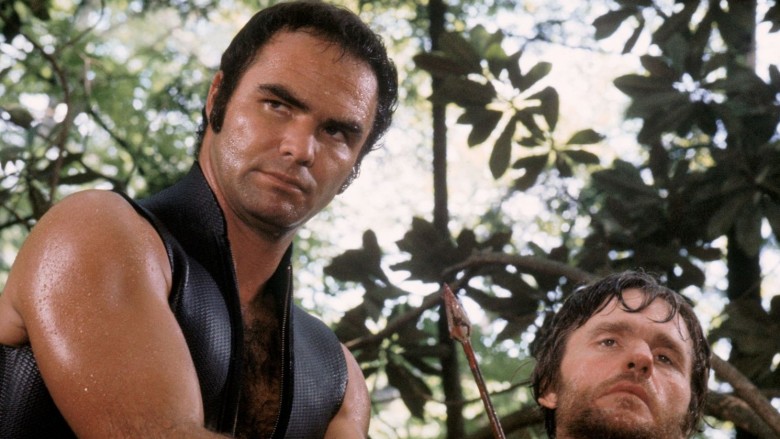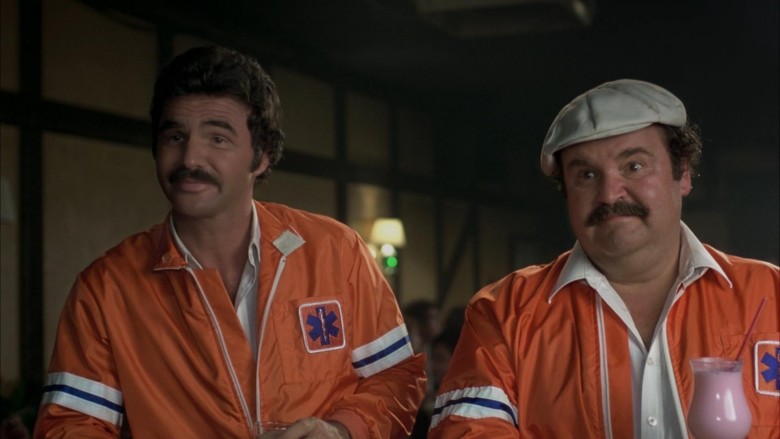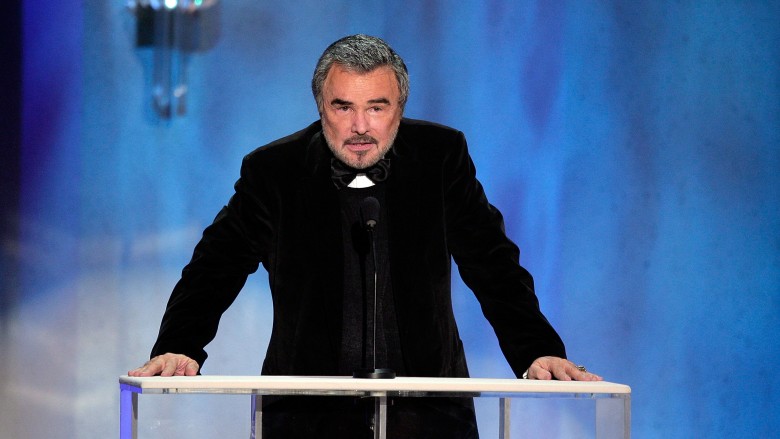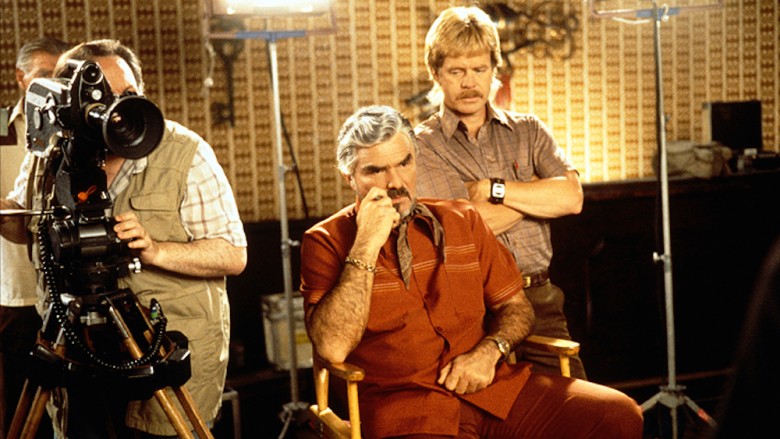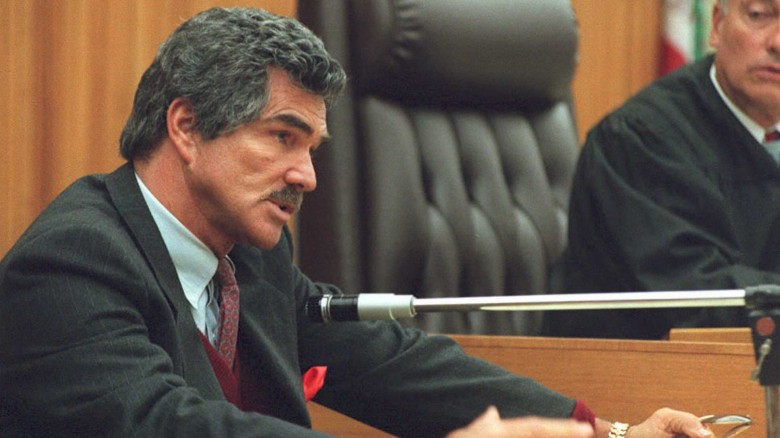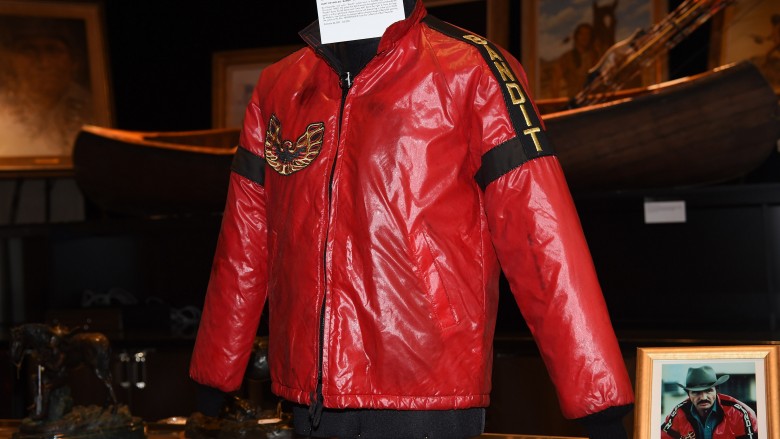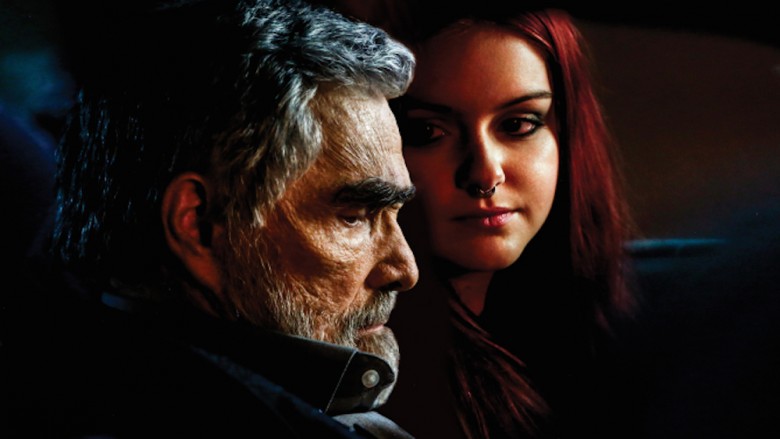The Real Reason You Don't Hear From Burt Reynolds Anymore
We may receive a commission on purchases made from links.
With acclaimed roles in Deliverance and The Longest Yard, Burt Reynolds's swagger and charm made him a huge star in the 1970s. His on-screen persona was cemented by Smokey and the Bandit, a massive financial success that spawned two sequels. But despite his box-office clout and sex symbol status, the once-great star has faded away, and if you want to know where the guy from Boogie Nights has gone, then keep on reading to find out whatever happened to Burt Reynolds.
Becoming a star
Though Burt Reynolds had his breakout with Deliverance, it was far from his first role. Reynolds began his career in the late '50s and worked steadily with small TV roles all through the '60s. One time, he even appeared on an episode of The Twilight Zone, playing a cocky acting student who gets punched in the face by a time-traveling Shakespeare.
Then in 1972, Deliverance gave Reynolds his first major movie role, and the picture was a hit that put Reynolds in the spotlight. But just before his breakout film was released, Reynolds decided to pose nude for Cosmopolitan. It was the first nude male centerfold in a major magazine, and the actor figured it would be funny, something people would look at and laugh and forget about a few days later. But his Cosmo edition flew off the shelves. The photo was everywhere, and though it made Reynolds the sex symbol of the '70s, it also diminished his serious acting accomplishments in Deliverance. Burt Reynolds was now a huge star, but he was never really taken seriously, something that would bother him for the rest of his career.
A few bad choices
Through the '70s, Reynolds was everywhere. His signature mustache and cocky smile won over male and female fans alike. Even in fairly silly films like Smokey and the Bandit, Reynolds made it work through sheer force of charisma alone.
However, by the '80s, his movies were getting further and further from critical acclaim. The Cannonball Run featured an all-star cast (and an early American film appearance by Jackie Chan) and made a lot of money, but critics weren't pleased. Roger Ebert wrote, "The Cannonball Run is an abdication of artistic responsibility at the lowest possible level of ambition. In other words, they didn't even care enough to make a good lousy movie."
In 1981, Reynolds starred in the well-reviewed drama Sharky's Machine, but he followed it up with Best Little Whorehouse in Texas, the forgettable Best Friends, and the horribly reviewed Stroker Ace. By the time 1984 rolled around, Reynolds returned for Cannonball Run II, which got even worse reviews and made $44 million less than the original. By sticking to a run of mediocre comedies, Reynolds was never going to be taken seriously, and his handsome charm could only impress audiences for so long.
The last half of the '80s were hard
If the early '80s seemed troublesome for Reynolds, the second half of the decade only got worse. After doing a cameo in the bizarre Smokey and the Bandit Part 3 (Sheriff Justice hallucinates talking to Burt Reynolds at the end), Reynolds appeared in disappointing dramas like City Heat and Stick. Things didn't get any better from there.
After doing a PSA with Judd Nelson about the dangers of teen drug use, Reynolds decided to make Rent-A-Cop in 1988. Someone thought it would be a great idea to pair Reynolds and Liza Minnelli as a disgraced cop and a prostitute who fall in love while hunting down a criminal. The New York Times wrote of his performance, "Mr. Reynolds does his customary number, but somewhat more sluggishly than usual; he produces no sparks." The old Reynolds charm was wearing off, and fan interest waned as the '90s came around.
Aging out
Being the prime stud of the '70s was great, but by the time the '90s rolled around, Reynolds couldn't quite pull off the ladies man schtick anymore. After all, the '90s were a time of irony and disenchantment. So it makes sense that Nirvana and Burt Reynolds weren't popular in the same era. Reynolds style of machismo and comedy had completely fallen out of fashion. Instead, movies like Reality Bites and Clueless were hits, and this kind of stuff was about as far away from a Reynolds film as you could get. Though the actor did have some box-office success in the '90s with Cop and a Half, the movie was a critical failure.
Too many refusals
Over the years, Reynolds turned down a lot of roles that would wind up becoming iconic characters. In an interview with Business Insider, Reynolds admitted regret for some of the parts that could've been. For example, Reynolds says he could've played the first American James Bond, but he felt 007 was a role only an Englishman could play. Before Harrison Ford took a break from carpentry to play Han Solo, Reynolds was allegedly offered the role. But for some reason, the actor just didn't connect with the part. "Now I regret it. I wish I would have done it," Reynolds said.
In 1990, Reynolds got first dibs on the role that would ultimately go to Richard Gere in Pretty Woman. Though it was a huge hit for Gere and made Julia Roberts famous, Reynolds didn't mind missing out on this one. He felt he'd be a strange on-screen pairing for Julia Roberts. And since Reynolds was 54 at the time and Roberts was 23, it's probably a good thing he didn't wind up in the movie.
The one film Reynolds really wishes he'd done was Terms of Endearment. James L. Brooks wrote the lead male character especially for Reynolds, but the star said no, as he'd already committed to playing in Stroker Ace. While all these choices didn't affect his career at the time (Reynolds did just fine in the '70s without Bond or Solo), overall they hurt his legacy. He could be an Oscar-winner now or part of one of the most popular franchises of all-time. Sean Connery, Jack Nicholson, and Harrison Ford are all taken seriously, even today, in a way that Reynolds never was. But if he'd said "yes "a little more, things might've been totally different.
Television success
Though film success was elusive in the early '90s for Reynolds, he came back to TV for the sitcom Evening Shade. The show found Reynolds playing a character named Wood Newton, a former pro-football player who returns to his hometown to coach the local high school team. The program featured familiar names like Michael Jeter, Hal Holbrook, Ossie Davis, and Charles Durning, and it was well-liked by audiences. In fact, Reynolds won his first and only Emmy for his performance, and he even tried his hand at directing, successfully stepping behind the camera for a number of episodes. Unfortunately, after four seasons, the show went off the air and Reynolds went back to making bad movies...well, until a young auteur named Paul Thomas Anderson came along, anyway.
A thwarted comeback
In 1997, Reynolds got the comeback role of a lifetime. In Boogie Nights, he played a notable porn director saddened that the art of adult films was fading away with the times. The film made Paul Thomas Anderson a new hot director, and it gave Reynolds acclaim that he hadn't seen in a long time. As The New York Times wrote, "Burt Reynolds rises to this occasion by giving his best and most suavely funny performance in many years."
But while he was acclaimed by critics, Reynolds didn't really go anywhere after playing the part of Jack Horner. So why didn't Boogie Nights work for Reynolds like Pulp Fiction did for John Travolta? Well, first of all, Reynolds didn't like Boogie Nights. Though he's never watched the whole film, Reynolds told The Guardian that he still hates the movie and that working on it was a nightmare.
Evidently, the actor considered Paul Thomas Anderson to be cocky, and that didn't sit well with Reynolds. Elaborating on his feelings, Reynolds once said, "Every shot we did, it was like the first time [that shot had ever been done]. I remember the first shot we did in Boogie Nights, where I drive the car to Grauman's Theater. After he said, 'Isn't that amazing?' And I named five pictures that had the same kind of shot. It wasn't original."
Reynolds also seemed to think this was just a glorified porn film, so he was rarely happy on set. He fought constantly with Anderson. In fact, the movie's first assistant director recalled a screaming match where Reynolds called Anderson a "little punk kid" and said the director couldn't tell him what to do.
Reynolds also had problems with some of his fellow cast members. For example, Reynolds nearly punched out Thomas Jane. In his book But Enough About Me, Reynolds recalled a moment where Jane was allegedly getting kind of physical with some of the people on set. "When he put his martial arts moves on me, I said 'Don't make the mistake of pushing me, I push back.'" Jane laughed, and Reynolds unleashed some R-rated language before storming off the set.
Though the shoot was difficult, Anderson had no complaints about Reynolds's performance. He even offered him a role in his next film, Magnolia. But Reynolds turned it down, saying, "I'd done my picture with Paul Thomas Anderson, that was enough for me."
Personal difficulties
In addition to his flailing film career, things were also pretty difficult in Reynolds's personal life. After marrying actress Loni Anderson, which later Reynolds called "a really dumb move," they divorced in 1993. It was not amicable.
Reynolds spoke terribly of Anderson, saying she was a bad mother and insinuating that she'd cheated on him. Anderson claimed that Reynolds abused her. All in all, it was a very vicious divorce. Reynolds agreed to pay Anderson a little under $250,000 for the settlement, though he didn't complete the transaction right away. In fact, it took 22 years for Reynolds to complete his payments. By dragging the divorce out for decades, it made Reynolds look bad in the press and hinted at possible money issues.
Money problems
Reynolds made a lot of cash during the course of his lengthy career, but that doesn't mean he was good at hanging onto his dough. In 1996, he filed for bankruptcy, but was able to keep his large ranch in Florida. In 2014, money was still a problem, so he held an auction of some of his personal belongings. Some of the items on sale were props and costumes from his films, and he even auctioned his award for being the biggest box-office draw of 1977. However, other items were a little more desperate, like his used credit card. In other words, when you're trying to sell a voided American Express card, things aren't going all that great.
He's still busy
Despite all these bumps in the road, Burt Reynolds is still working. It's just not always on the big screen. For example, he created the Burt Reynolds Institute, an acting studio in Florida where aspiring thespians can learn from Reynolds himself. In 2015, he wrote a memoir entitled But Enough About Me, a book that details his fascinating life. Reynolds may not be the same stud of the '70s, but his cocky charm comes through on every page.
And while he might not be in working in blockbuster films, Reynolds hasn't stopped acting. At 81, he completed the film Dog Years, also starring Ariel Winter from Modern Family. Plus, the man has one film in post-production and two scheduled for release in 2017. For a guy who's been in the business almost 60 years, that's incredibly impressive. Reynolds star may not shine as bright today as it did 40 years ago, but he's still an icon who'll always have a place in film history.

